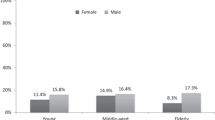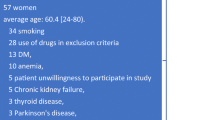Abstract
Objectives
Apelin is an antioxidant and anti-inflammatory molecule secreted by adipose tissue and has a protective effect on cardiac and neuronal tissue. Recent studies have reported that the risk of vascular disease is increased in restless legs syndrome (RLS). We aimed to measure plasma levels of apelin in patients with RLS. Additionally, we wanted to determine if there is any relationship between apelin levels and RLS disease severity and the periodic leg movement index (PLMI).
Method
A total of 14 RLS patients with moderate-to-severe symptoms and 14 age- and body mass index (BMI)-matched healthy controls participated in the study. All participants had no concomitant medical disorder nor took medications. The international RLS rating scale (IRLSS) was used to determine disease severity. Polysomnography (PSG) served to exclude other sleep disorders such as sleep-related breathing disorders and to measure sleep parameters.
Results
The mean plasma apelin level was significantly lower in the patient group compared to the control group independent of IRLSS score and PSG findings (p = 0.004). After comparison between the RLS patient group and control group, the patient group was divided into two subgroups based on a PLMI above or below 15 events per hour. A reduced mean apelin level was observed in the patient group having a PLMI above 15 compared to the patient group with PLMI below 15 and the control group (p = 0.003). There was no correlation between plasma apelin levels and disease severity and PLMI in the two patient subgroups.
Conclusions
RLS patients especially those with a PLMI above 15 have low plasma apelin levels independent of disease severity and sleep parameters such as sleep duration and quality. Decreased apelin levels may explain the increased risk for vascular diseases in those patients.
Similar content being viewed by others
References
Sateia M (2014) International classification of sleep disorders third edition: highlights and modifications. Chest 146:1387–1394. doi:10.1378/chest.14-0970
Rangarajan S, Rangarajan S, D’Souza GA (2007) Restless legs syndrome in an Indian urban population. Sleep Med 9:88–93. doi:10.1016/j.sleep.2006.11.004
Sevim S, Dogu O, Camdeviren H et al (2003) Unexpectedly low prevalence and unusual characteristics of RLS in Mersin, Turkey. Neurology 61:1562–1569. doi:10.1212/01.WNL.0000096173.91554.B7
Allen RP, Bharmal M, Calloway M (2011) Prevalence and disease burden of primary restless legs syndrome: results of a general population survey in the United States. Mov Disord 26:114–120. doi:10.1002/mds.23430
Phillips B, Young T, Finn L et al (2000) Epidemiology of restless legs symptoms in adults. Arch Intern Med 160:2137–2141. doi:10.1001/archinte.160.14.2137
Berger K, Luedemann J, Trenkwalder C et al (2004) Sex and the risk of restless legs syndrome in the general population. Arch Intern Med 164:196–202. doi:10.1001/archinte.164.2.196
Montplaisir J, Boucher S, Poirier G et al (1997) Clinical, polysomnographic, and genetic characteristics of restless legs syndrome: a study of 133 patients diagnosed with new standard criteria. Mov Disord 12:61–65. doi:10.1002/mds.870120111
Ohayon MM, O’Hara R, Vitiello MV (2012) Epidemiology of restless legs syndrome: a synthesis of the literature. Sleep Med Rev 16:283–295. doi:10.1016/j.smrv.2011.05.002
Ekbom K, Ulfberg J (2009) Restless legs syndrome. J Intern Med 266:419–431. doi:10.1111/j.1365-2796.2009.02159.x
Wesstrom J, Nilsson S, Sundstrom-Poromaa I et al (2008) Restless legs syndrome among women: prevalence, co-morbidity and possible relationship to menopause. Climacteric 11:422–428. doi:10.1080/13697130802359683
Winkelman JW, Finn L, Young T (2006) Prevalence and correlates of restless legs syndrome symptoms in the Wisconsin Sleep Cohort. Sleep Med 7:545–552. doi:10.1016/j.sleep.2006.01.004
Li Y, Walters AS, Chiuve SE et al (2012) Prospective study of restless legs syndrome and coronary heart disease among women. Circulation 126:1689–1694. doi:10.1161/CIRCULATIONAHA.112.112698
Winkelman JW, Shahar E, Sharief I et al (2008) Association of restless legs syndrome and cardiovascular disease in the Sleep Heart Health Study. Neurology 70:35–42. doi:10.1212/01.wnl.0000287072.93277.c9
Minai OA, Malik N, Foldvary N et al (2008) Prevalence and characteristics of restless legs syndrome in patients with pulmonary hypertension. J Heart Lung Transplant 27:335–340. doi:10.1016/j.healun.2007.12.008
Pennestri MH, Montplaisir J, Colombo R et al (2007) Nocturnal blood pressure changes in patients with restless legs syndrome. Neurology 68:1213–1218. doi:10.1212/01.wnl.0000259036.89411.52
Baskol G, Korkmaz S, Erdem F et al (2012) Assessment of nitric oxide, advanced oxidation protein products, malondialdehyde, and thiol levels in patients with restless legs syndrome. Sleep Med 13:414–418. doi:10.1016/j.sleep.2011.11.012
Kawamata Y, Habata Y, Fukusumi S et al (2001) Molecular properties of apelin: tissue distribution and receptor binding. Biochim Biophys Acta 1538:162–171. doi:10.1016/S0167-4889(00)00143-9
Carpene C, Dray C, Attane C et al (2007) Expanding role for the apelin/APJ system in physiopathology. J Physiol Biochem 63:359–373
Foussal C, Lairez O, Calise D et al (2010) Activation of catalase by apelin prevents oxidative stress-linked cardiac hypertrophy. FEBS Lett 584:2363–2370. doi:10.1016/j.febslet.2010.04.025
Than A, Zhang X, Leow MK et al (2014) Apelin attenuates oxidative stress in human adipocytes. J Biol Chem 289:3763–3774. doi:10.1074/jbc.M113.526210
Chun HJ, Ali ZA, Kojima Y et al (2008) Apelin signaling antagonizes Ang II effects in mouse models of atherosclerosis. J Clin Invest 118:3343–3354. doi:10.1172/JCI34871
Zeng XJ, Yu SP, Zhang L et al (2010) Neuroprotective effect of the endogenous neural peptide apelin in cultured mouse cortical neurons. Exp Cell Res 316:1773–1783. doi:10.1016/j.yexcr.2010.02.005
Berry RB, Brooks R, Gamaldo CE, et al. (2012) The AASM manual for the scoring of sleep and associated events: rules, terminology and technical specifications. Version 2.0 Web site. www.aasm.org. Darien (IL): American Academy of Sleep Medicine. Accessed 1 June 2014
Walters AS, LeBrocq C, Dhar A et al (2003) Validation of the International Restless Legs Syndrome Study Group rating scale for restless legs syndrome. Sleep Med 4:121–132. doi:10.1016/S1389-9457(02)00258-7
Koo BB, Blackwell T, Ancoli-Israel S et al (2011) Association of incident cardiovascular disease with periodic limb movements during sleep in older men: outcomes of sleep disorders in older men (MrOS) study. Circulation 124:1223–1231. doi:10.1161/CIRCULATIONAHA.111.038968
Winter AC, Schurks M, Glynn RJ et al (2012) Restless legs syndrome and risk of incident cardiovascular disease in women and men: prospective cohort study. BMJ Open 2(2):e000866. doi:10.1136/bmjopen-2012-000866
Cosentino FI, Arico D, Lanuzza B et al (2011) Absence of cardiovascular disease risk factors in restless legs syndrome. Acta Neurol Scand 125:319–325. doi:10.1111/j.1600-0404.2011.01563.x
Siddiqui F, Strus J, Ming X et al (2007) Rise of blood pressure with periodic limb movements in sleep and wakefulness. Clin Neurophysiol 118:1923–1930. doi:10.1016/j.clinph.2007.05.006
Winkelman JW (1999) The evoked heart rate response to periodic leg movements of sleep. Sleep 22:575–580
Weinstock LB, Walters AS, Paueksakon P (2012) Restless legs syndrome—theoretical roles of inflammatory and immune mechanisms. Sleep Med Rev 16:341–354. doi:10.1016/j.smrv.2011.09.003
Boucher J, Masri B, Daviaud D et al (2005) Apelin, a newly identified adipokine up-regulated by insulin and obesity. Endocrinology 146:1764–1771. doi:10.1210/en.2004-1427
Rai MF, Sandell LJ, Cheverud JM et al (2013) Relationship of age and body mass index to the expression of obesity and osteoarthritis-related genes in human meniscus. Int J Obes 37:1238–1246. doi:10.1038/ijo.2012.221
Cox CM, D’Agostino SL, Miller MK et al (2006) Apelin, the ligand for the endothelial G-protein-coupled receptor, APJ, is a potent angiogenic factor required for normal vascular development of the frog embryo. Dev Biol 296:177–189. doi:10.1016/j.ydbio.2006.04.452
Foldes G, Horkay F, Szokodi I et al (2003) Circulating and cardiac levels of apelin, the novel ligand of the orphan receptor APJ, in patients with heart failure. Biochem Biophys Res Commun 308:480–485. doi:10.1016/S0006-291X(03)01424-4
Han S, Wang G, Qiu S et al (2007) Increased colonic apelin production in rodents with experimental colitis and in humans with IBD. Regul Pept 142:131–137. doi:10.1016/j.regpep.2007.02.002
Iwagana Y, Kihara Y, Takenaha H et al (2006) Down-regulation of cardiac apelin system in hypertrophied and failing hearts: possible role of angiotensin II-angiotensin type 1 receptor system. J Mol Cell Cardiol 41:798–806. doi:10.1016/j.yjmcc.2006.07.004
Sheibani S, Hanachi P, Refahiat MA (2012) Effect of aerobic exercise on serum concentration of apelin, TNFα and insulin in obese women. Iran J Basic Med Sci 15:1196–1201
Li Y, Wang W, Winkelman JW et al (2013) Prospective study of restless legs syndrome and mortality among men. Neurology 81:52–59. doi:10.1212/WNL.0b013e318297eee0
Acknowledgments
We would like to thank to Dr Mark Hallett and Devee Schoenberg for the editing support.
Author information
Authors and Affiliations
Corresponding author
Ethics declarations
Funding
Turkish Sleep Medicine Society provided financial support in the form of Grant number TSMS2013/01 funding.
Conflict of interest
All authors certify that they have no affiliations with or involvement in any organization or entity with any financial interest (such as honoraria; educational grants; participation in speakers’ bureaus; membership, employment, consultancies, stock ownership, or other equity interest; and expert testimony or patent-licensing arrangements) or non-financial interest (such as personal or professional relationships, affiliations, knowledge or beliefs) in the subject matter or materials discussed in this manuscript.
Ethical approval
All procedures performed in studies involving human participants were in accordance with the ethical standards of the institutional and/or national research committee and with the 1964 Helsinki Declaration and its later amendments or comparable ethical standards.
Informed consent
Informed consent was obtained from all individual participants included in the study.
Rights and permissions
About this article
Cite this article
Korkmaz, S., Aksu, M. & Baskol, G. Plasma apelin level in patients with restless legs syndrome and its association with periodic leg movements. Sleep Breath 21, 19–24 (2017). https://doi.org/10.1007/s11325-016-1355-7
Received:
Revised:
Accepted:
Published:
Issue Date:
DOI: https://doi.org/10.1007/s11325-016-1355-7




